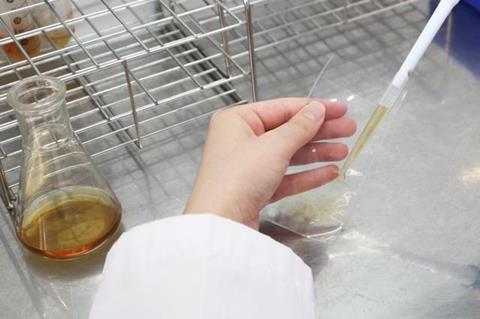Culturing is a basic yet indispensable method in microbiology research. Microorganisms are often cultured in a liquid medium that provides essential nutrients, and this process is both simple and highly effective.

In addition to nutrients, oxygen availability is also critical for the growth of aerobic microorganisms. However, oxygen does not dissolve easily in the liquid medium. As a result, the medium needs to be forcibly aerated, usually by shaking.
READ MORE: Agar and the curse of purity
READ MORE: Non-culturable Legionella identified with sequencing
Several techniques have been developed for better aeration of ‘shake’ cultures, including ’baffled’ shake flasks, which have indentations designed to improve oxygen transfer, and supplying air bubbles to bioreactors. However, these conventional shake cultures pose a significant issue by subjecting microorganisms to physical (shear) stress.
Static culturing
Now, in a study published online on October 10, 2024 in Scientific Reports, a team of researchers from Kindai University in Japan, led by Professor Motomu Akita and Dr. Kenji Ito (also affiliated with Cell Film Lab. Co. Ltd.), have demonstrated a novel method for ’static’ culturing of bacteria in a liquid medium.
To achieve this, they utilized a polymer called TPX which is highly permeable to small molecular weight gases, including oxygen. A bag made of TPX film was filled with a small amount of liquid medium, inoculated with bacteria, and was kept on a flat surface to enable the formation of a thin layer of medium that could be used for culturing.
Using this method, the researchers successfully cultured Escherichia coli, which showed similar growth in the film bag and in liquid shake cultures. To test whether this method ensured sufficient oxygen availability, they also cultured Komagataella phaffi, which requires high amounts of oxygen for its growth. They observed that the growth of K. phaffi was slightly lower in the film bag than in the conventional shake cultures.
Advantages over conventional methods
Using a film bag has several advantages over conventional culturing methods. “Our method enables easy observation of biological phenomena that were previously unobservable,” explains Prof. Akita. “Until now, microorganisms have not been cultured in liquid conditions where sufficient oxygen was supplied and physical stress was absent.”
With this method, researchers now have the opportunity to closely examine how microorganisms behave when they are not subjected to shear stress.
One observable phenomenon in this regard is the growth of ’biofilms’, gel-like layer formation resulting from microorganisms adhering to a surface. Normally, biofilms cannot form in liquid cultures that are subjected to shaking. However, the present study demonstrated that static culturing of Bacillus species resulted in biofilm formation along the bottom of the film bag.
Possibilities are enormous
“The possibilities for this new culturing method are enormous. For starters, reducing the space, energy and resources needed to culture bacteria could promote more sustainable research activities,” says Prof. Akita. “This means experiments could be conducted even in limited physical spaces, or when culturing equipment is constrained.”
The new method could have potential applications in science, medicine, and industry research, spanning diverse fields that include education, healthcare, food production, and space exploration. For example, it could be used to conduct experiments in remote locations such as the polar regions or even space stations. Other potential applications include advancing research in laboratories with limited budgets, simplifying procedures in medical centers, enabling on-site culturing during field research, and facilitating educational experiments in schools.







No comments yet